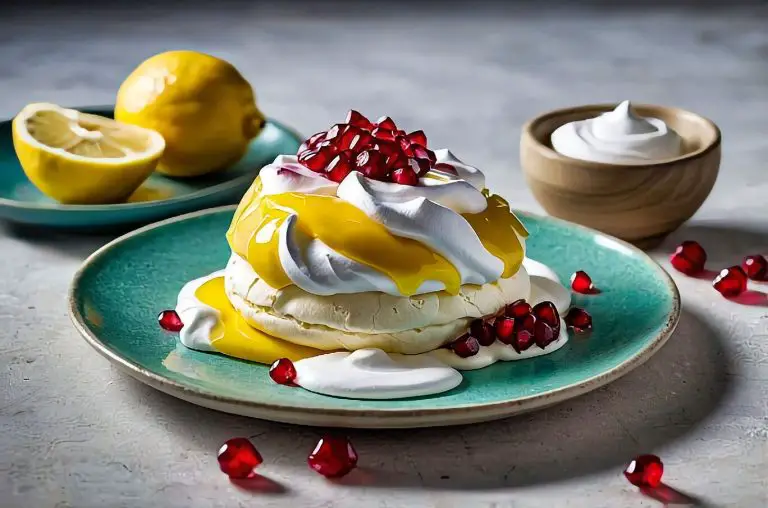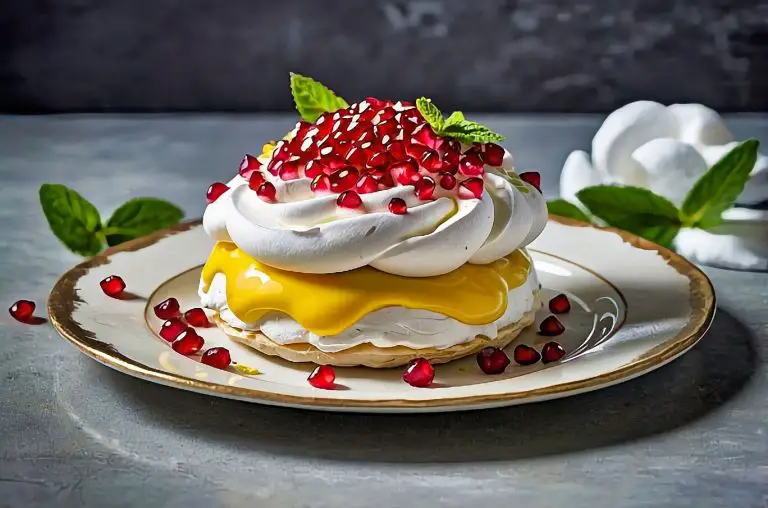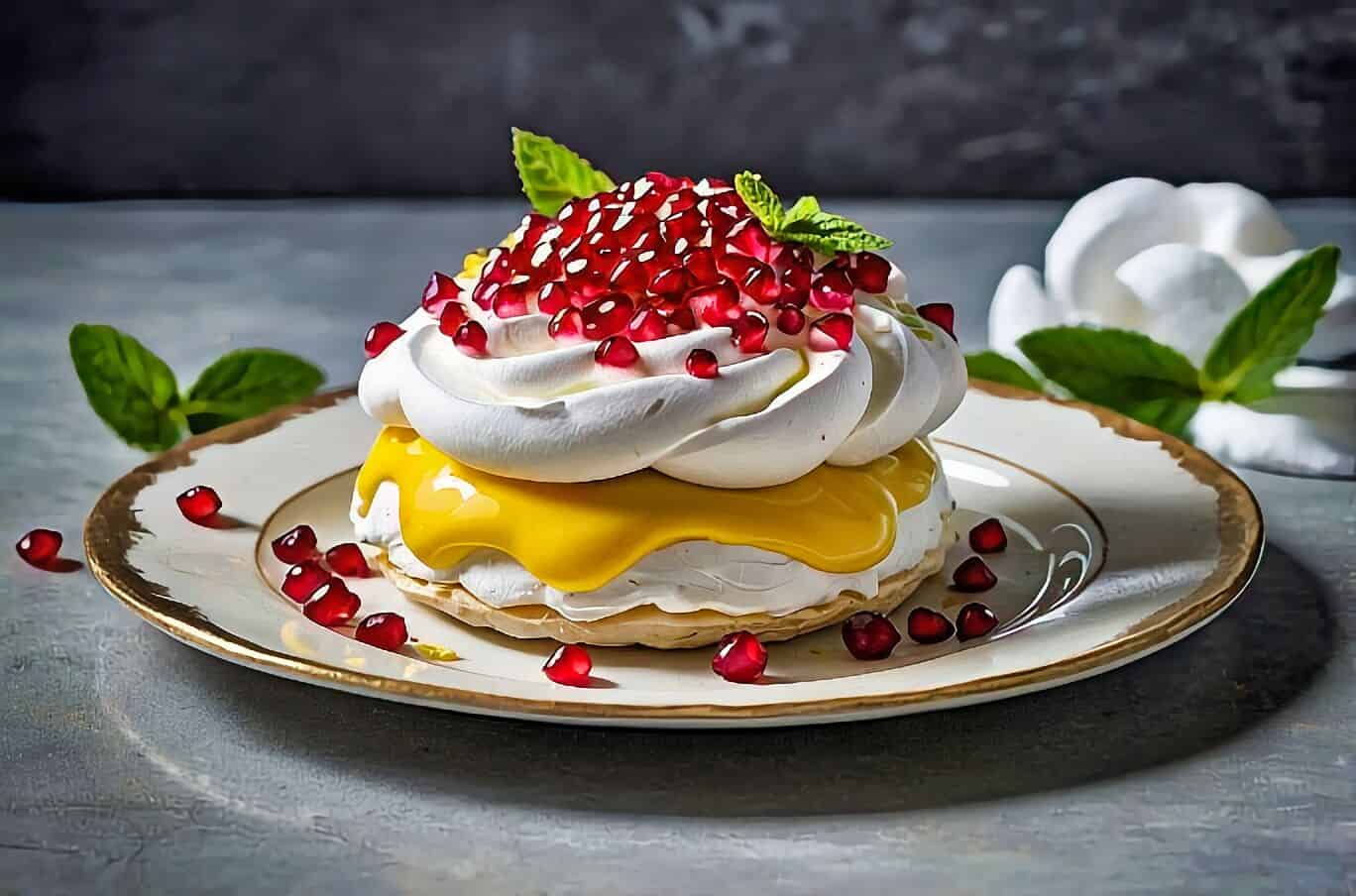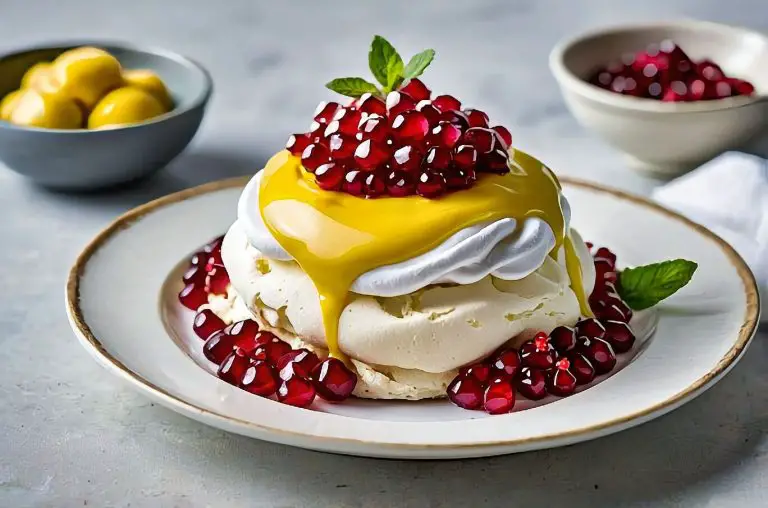The New Zealand Lemon Curd Pomegranate Pavlova Recipe always comes to mind when I think of iconic desserts This delicious dessert combines a crisp, light meringue shell with creamy lemon curd and vibrant pomegranate, making it a stunning centerpiece for any occasion. It’s a delightful twist on a Kiwi classic that showcases the perfect balance of sweetness and tartness.
I love how the combination of flavors and textures creates something truly special. The crunchy exterior gives way to a soft, marshmallow-like center that works beautifully with the zesty lemon curd, while the pomegranate seeds add a burst of color and freshness. This dessert not only tastes incredible but also looks amazing on the table, sure to impress any guest.
Whether you’re celebrating a special event or simply want to treat yourself, this New Zealand lemon curd pomegranate pavlova is the perfect choice. I can’t wait to share the step-by-step process to help you create this delightful dessert right in your own kitchen!
The History of Pavlova
The pavlova is a beloved dessert with a rich history. Its creation is tied to both New Zealand and Australia, leading to fierce debates over its true origin. I find this story fascinating, with various accounts adding layers to this dessert’s legacy.
Origin Stories
The pavlova dessert is named after Russian ballerina Anna Pavlova. She toured Australia and New Zealand in 1926, inspiring a Wellington hotel chef to create this light, meringue-based treat. The story goes that the chef drew inspiration from Pavlova’s flowing tutu.
New Zealand claims to have the first pavlova recipe, while Australians assert it originated in their country. Helen Leach, an esteemed food anthropologist, documented numerous pavlova recipes in New Zealand cookbooks, dating back to the early 20th century. This has led to a spirited rivalry and intense pride in both nations regarding the pavlova’s heritage.
Global Popularity
Over the years, the pavlova has gained global recognition, evolving into a quintessential Kiwi classic. Its unique texture—crispy on the outside and soft inside—makes it a favorite for many dessert lovers.
I appreciate how the dessert was influenced by European immigrants, bringing variations to New Zealand and Australia. Interestingly, a pavlova-like recipe appeared on a 1890s corn starch container in America, showcasing its widespread appeal. Today, pavlova is enjoyed beyond its origins, with many countries incorporating local flavors, like lemon curd or pomegranate, into this timeless dessert.
Essential Ingredients
The success of my New Zealand Lemon Curd Pomegranate Pavlova hinges on selecting the right ingredients. Each component contributes to the dessert’s texture and flavor. Let’s focus on choosing quality produce and explore some variations or substitutes.
Selecting Quality Produce
When preparing pavlova, I always start with fresh egg whites. They should be at room temperature for better whipping. Look for caster sugar, as its fine texture dissolves easily, creating a smooth meringue.
For the filling, using homemade lemon curd elevates the taste. If time is tight, store-bought works too. I recommend selecting fresh and juicy pomegranate seeds. They add a lovely burst of flavor.
Don’t forget the cream! A high-fat content cream whips up beautifully. If I want to enhance the flavor, I often add a splash of vanilla. To complete the look, fresh mint leaves or slices of kiwi fruit can make a delightful garnish.
Variations and Substitutes
While I love the classic combination, there are many ways to adapt the recipe. For a different texture, I might mix in a bit of cornstarch or cornflour into the meringue. It helps create a softer inside.
If I’m out of caster sugar, fine granulated sugar works well, although it may take a bit longer to dissolve. For a citrus twist, I sometimes incorporate other fruits like strawberries. They pair nicely with the lemon and pomegranate.
Overall, with a bit of creativity, I can tailor the dish to my preference while maintaining that delightful pavlova spirit!
Preparing the Meringue Base
Creating a meringue base for your New Zealand Lemon Curd Pomegranate Pavlova is a delightful process. Getting the right texture is essential for that perfect balance of crispy exterior and soft interior. Let’s break down how I achieve that perfect consistency and explore some creative shapes for my pavlova.
Achieving the Perfect Consistency
To start, I gather my main ingredients: egg whites, caster sugar, cornflour, and a hint of vanilla extract. It’s crucial to use fresh egg whites, as they whip better. I begin by beating the egg whites in a clean, dry bowl until soft peaks form.
Next, I add caster sugar gradually, allowing it to dissolve completely. The key here is to beat until I have a glossy mixture that forms stiff peaks. Incorporating cornflour helps stabilize the meringue, giving it that classic lightness. A small amount of lemon rind can be added for a subtle flavor, complementing the pavlova’s final layers.
Creative Shapes and Forms
With the meringue ready, I can play with shapes. Using a Swiss roll tin allows for a rolled pavlova style, which is visually stunning. I spread the meringue evenly into the tin, ensuring it reaches the edges for a uniform bake.
Alternatively, I can spoon the meringue onto a baking sheet, creating nests or circles for individual portions. By using the back of a spoon, I can shape wells for filling later. This method gives me beautiful presentations that showcase the lemon curd and pomegranate. Each shape has its charm, and they can elevate my pavlova experience.

Assembly and Toppings
When it comes to assembling my New Zealand Lemon Curd Pomegranate Pavlova, attention to detail makes a difference. The layering of the components and the choice of toppings not only enhance the dessert’s flavor but also its visual appeal.
Layering the Pavlova
To start, I carefully peel off the cooled pavlova from the baking paper. I then place it on a serving platter, ensuring it’s a nice canvas for my toppings.
I spread a generous layer of whipped cream across the surface. This creamy layer complements the tartness of the lemon curd, which I then dollop in the center. I gently swirl the lemon curd into the cream for a pleasing marbled effect.
Next, I sprinkle pomegranate seeds generously over the entire pavlova. These seeds add a pop of color as well as a refreshing crunch. Finally, if I’m feeling adventurous, I might add a few slices of kiwi fruit for a tropical twist.
Decorating with Fruits
For the finishing touches, I love decorating with fresh berries. I opt for a mix of strawberries and blueberries, as their vibrant colors enhance the pavlova’s appearance.
I scatter these berries around the top, ensuring each slice will have a delightful fruit surprise.
To elevate the presentation, I add a few sprigs of mint leaves. The coolness of mint perfectly balances the sweetness and tartness, creating an appealing contrast.
If desired, I drizzle a little extra lemon curd on top for a zesty kick. This eye-catching and flavorful ensemble transforms the pavlova into a stunning centerpiece, perfect for any gathering.
Serving and Storage Tips
Keeping your New Zealand Lemon Curd Pomegranate Pavlova fresh and delightful is easy when you follow a few simple guidelines. I’ve found that serving it just right and knowing how to store leftovers can enhance the overall experience.
Best Practices for Freshness
To ensure that your pavlova stays crisp and delicious, it’s best to assemble the dessert right before serving. The meringue base tends to absorb moisture over time, which can make it soft.
When preparing the pavlova, line your baking tray with baking paper to prevent sticking. Let the meringue cool completely before adding lemon curd and whipped cream. If you anticipate leftovers, store the components separately.
Place the pavlova base covered at room temperature. The lemon curd and whipped cream should go in the refrigerator. As long as they are kept separate, they can maintain their textures for up to 24 hours.
From Leftovers to Eton Mess
If you find yourself with leftover pavlova, a delicious transformation awaits! I often turn it into a charming Eton Mess.
To do this, crumble the pavlova and mix it gently with aged lemon curd and any remaining whipped cream. Add some fresh berries or pomegranate seeds for an extra burst of flavor and color.
This simple dessert is not only quick to prepare but also retains the pavlova’s lightness while offering a different texture. It’s a wonderful way to use leftovers while still enjoying that delightful taste of lemon curd and pomegranate.
Ingredients For the New Zealand Lemon Curd Pomegranate Pavlova Recipe
Egg Whites
Sugar
Cream
Lemon Curd
Pomegranate Seeds
Mint Leaves

Cooking Instructions For the New Zealand Lemon Curd Pomegranate Pavlova Recipe
Preheat the oven to 160°C and line a 20x30cm Swiss roll tin with baking paper, sprinkling the base with 2 Tbsp of sugar.
Beat egg whites in a large bowl until stiff, then gradually add the remaining sugar, beating until dissolved. Spread evenly in the tin and bake for 12-15 minutes until set.
Place a sheet of baking paper on a work surface, sprinkle with sugar, and flip the pavlova onto it. Let cool, then carefully remove the paper.
Whip the cream until stiff. Spread lemon curd over the pavlova, followed by the whipped cream, and sprinkle with pomegranate seeds. Roll from the short end and transfer to a serving plate. Garnish with mint leaves and slice to serve.

FAQ For the Traditional New Zealand Lemon Curd Pomegranate Pavlova Recipe
Question: What ingredients are needed for a Traditional New Zealand Lemon Curd Pomegranate Pavlova recipe?
A: A Traditional New Zealand Lemon Curd Pomegranate Pavlova recipe typically includes egg whites, sugar, cornstarch, vinegar, and vanilla for the meringue. The topping consists of lemon curd, fresh pomegranate seeds, and whipped cream for a balance of sweetness and tartness.
Question: How do you make a Traditional New Zealand Lemon Curd Pomegranate Pavlova recipe?
A: To make a Traditional New Zealand Lemon Curd Pomegranate Pavlova recipe, beat egg whites with sugar until stiff peaks form, then fold in cornstarch and vinegar. Bake at a low temperature until crisp on the outside. Once cooled, top with lemon curd, whipped cream, and pomegranate seeds.
Question: How do you prevent cracks in a Traditional New Zealand Lemon Curd Pomegranate Pavlova recipe?
A: To prevent cracks in a Traditional New Zealand Lemon Curd Pomegranate Pavlova recipe, avoid opening the oven door while baking. Let the pavlova cool slowly inside the oven with the door slightly ajar to prevent sudden temperature changes.
Question: Can you make a Traditional New Zealand Lemon Curd Pomegranate Pavlova recipe in advance?
A: Yes, a Traditional New Zealand Lemon Curd Pomegranate Pavlova recipe can be made in advance by preparing the meringue base a day ahead and storing it in an airtight container. Add the lemon curd, whipped cream, and pomegranate seeds just before serving.
Question: How should you store leftovers of a Traditional New Zealand Lemon Curd Pomegranate Pavlova recipe?
A: Leftovers of a Traditional New Zealand Lemon Curd Pomegranate Pavlova recipe should be stored in the refrigerator in an airtight container. The meringue may soften slightly, but it will still taste delicious within a day or two.

New Zealand Lemon Curd Pomegranate Pavlova Recipe
Ingredients
- 4 Egg Whites
- 1 cup Sugar caster
- 1 cup Cream
- ½ cup Lemon Curd
- ½ cup Pomegranate Seeds
- 1/2 cup Mint Leaves
Instructions
- Preheat the oven to 160°C and line a 20x30cm Swiss roll tin with baking paper, sprinkling the base with 2 Tbsp of sugar.
- Beat egg whites in a large bowl until stiff, then gradually add the remaining sugar, beating until dissolved. Spread evenly in the tin and bake for 12-15 minutes until set.
- Place a sheet of baking paper on a work surface, sprinkle with sugar, and flip the pavlova onto it. Let cool, then carefully remove the paper.
- Whip the cream until stiff. Spread lemon curd over the pavlova, followed by the whipped cream, and sprinkle with pomegranate seeds. Roll from the short end and transfer to a serving plate. Garnish with mint leaves and slice to serve.
Nutrition



1 comment
I learned how to make this at a cooking class but did not get the recipe there. Glad I found it here.